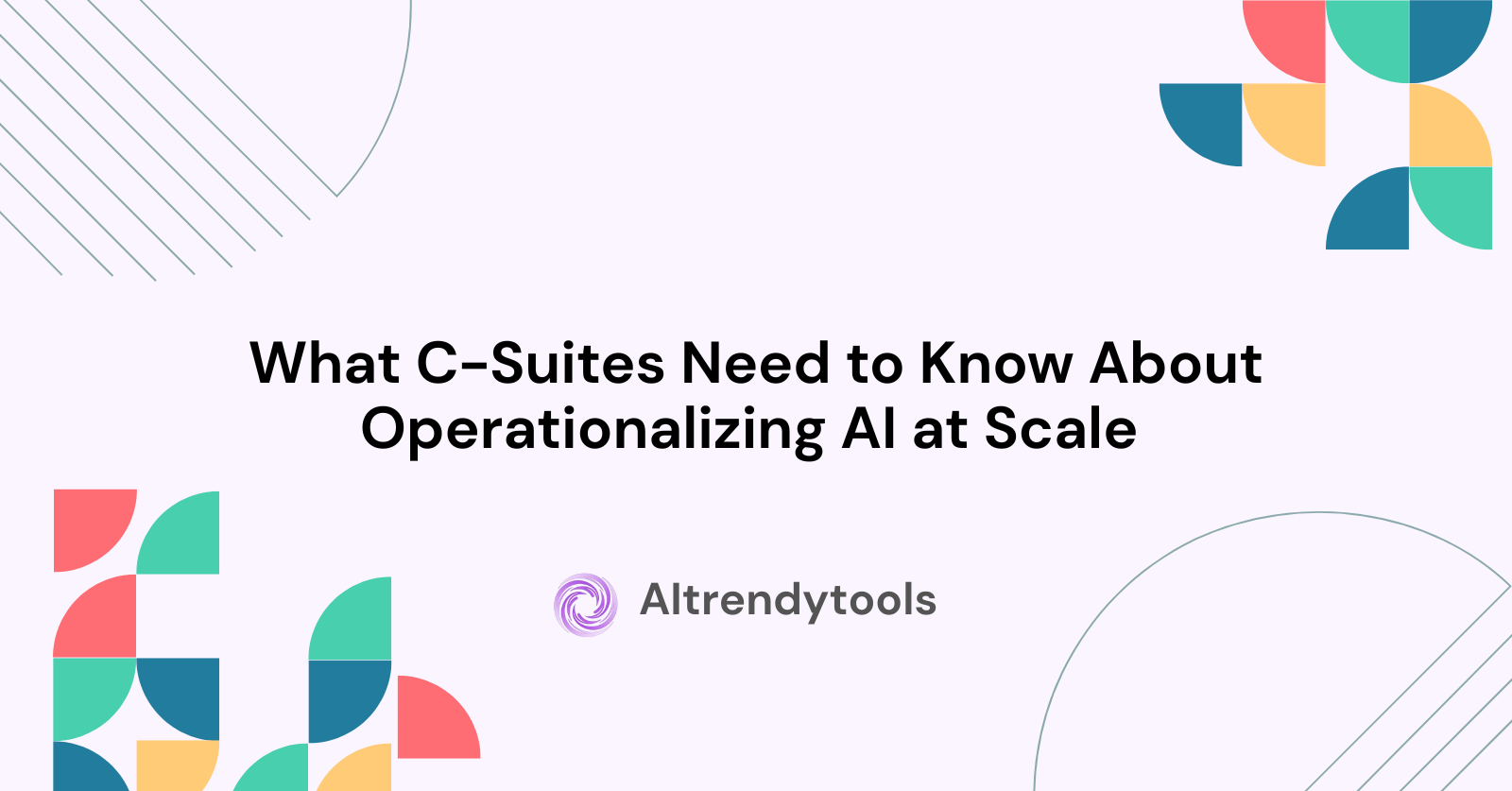🔥 AITrendytools: The Fastest-Growing AI Platform |
Write for usWhat C-Suites Need to Know About Operationalizing AI at Scale
Discover what executive leaders need to know to operationalize AI in enterprise—covering strategy, infrastructure, talent, governance, and cultural transformation for enterprise-wide impact.
Aug 12, 2025
AI has become more than a buzzword in boardrooms. It’s a business imperative. From predictive analytics and intelligent automation to personalized customer engagement, artificial intelligence promises transformation across the enterprise. But while pilots and proofs of concept may prove promising, operationalizing AI at scale remains one of the most complex and misunderstood journeys for enterprise leaders.
For C-suite executives, the question is no longer “Should we use AI?” but rather “How do we make AI work enterprise-wide and sustainably?” Achieving scale isn’t about deploying a few successful models—it’s about embedding AI into core operations, culture, and decision-making, with measurable impact.
This article breaks down what every executive team needs to understand about operationalizing AI in enterprise at scale, the risks and roadblocks, and how to architect a future-ready AI strategy.
From potential to practice: why scaling AI is difficult
Many companies successfully run AI pilots, but struggle to move them into production. McKinsey reports that while 70% of companies experiment with AI, only 15% succeed in scaling it. Why? Because scaling AI isn’t just a technical challenge—it’s a business transformation.
Here are the most common blockers:
- Fragmented data infrastructure: Disparate systems and siloed data make it hard to fuel models with clean, reliable inputs.
- Lack of AI talent and governance: Model development may be fast, but oversight, ethics, and lifecycle management are often afterthoughts.
- Legacy operating models: Traditional hierarchies and waterfall development cycles don’t fit the fast-moving nature of AI evolution.
- Fear of failure or ethical misuse: Concerns about AI hallucination, bias, or lack of explainability can stall adoption at the top.
To address these, executives must take a holistic view of AI as an enterprise capability—not a departmental project.
1. AI at scale requires executive sponsorship and strategy alignment
AI initiatives often fail not because of poor models, but because there is no overarching vision tying them to business value. For C-suites, the first priority is aligning AI to strategic priorities.
That means:
- Articulating clear value outcomes
AI must serve measurable goals—cost reduction, revenue growth, productivity gains, or customer retention.
- Defining success beyond the pilot
Success isn’t a well-performing model; it’s a production-ready system integrated into workflows.
- Driving cross-functional ownership
AI is not just IT or data science’s job. It needs champions in operations, legal, HR, and beyond.
For example, instead of a marketing team launching a standalone AI model to predict churn, a strategic approach integrates that model into the CRM and customer success workflows—with real-time triggers and human-in-the-loop feedback.
2. Building AI-Ready infrastructure is foundational
Behind every high-performing AI capability is a modern, scalable data and tech stack. Enterprises can’t scale AI if their architecture can’t support it.
Here’s what’s essential:
- Unified, governed data platforms: Centralizing data across silos and applying metadata, access control, and versioning is key.
- Cloud-native environments: Flexible compute, model deployment, and storage are necessary to handle the dynamic demands of AI workloads.
- MLOps and DevOps integration: Continuous model development, testing, monitoring, and retraining must be standardized like software pipelines.
CIOs and CTOs must lead modernization efforts with AI-readiness in mind. It’s not just about speed—it’s about creating environments where models can evolve with changing data, regulations, and business needs. Leveraging professional DevOps services can accelerate this transformation, ensuring infrastructure, workflows, and deployment pipelines are optimized for long-term AI scalability.
3. The role of AI governance can’t be an afterthought
AI governance isn’t just compliance theater—it’s a strategic lever. As models scale, so do risks related to bias, drift, IP, security, and customer trust.
C-suites must embed a governance framework that includes:
- Model accountability: Every AI output should have a traceable source, a responsible owner, and documented rationale.
- Bias monitoring and mitigation: Regular auditing of inputs and outcomes is vital for fairness and compliance.
- Ethical use policies: Create clear principles about where AI is acceptable, and where human oversight must remain.
By making governance proactive instead of reactive, organizations can scale responsibly—without slowing down innovation.
4. AI Talent must be embedded, not isolated
Hiring data scientists isn’t enough. To scale AI, organizations need blended teams and enterprise-wide fluency.
Leading companies are:
- Upskilling cross-functional teams in AI literacy, so product managers, marketers, and finance leaders can co-own AI initiatives.
- Deploying AI translators—professionals who can bridge technical and business needs, turning model insights into operational outcomes.
- Integrating AI roles into business units, not isolating them in a central innovation lab.
The future of AI is not just experts building models—it’s business units confidently adopting and adapting them.
5. Prioritize use cases that can be operationalized
One of the biggest pitfalls in scaling AI is focusing on novel use cases instead of valuable, scalable ones.
The C-suite should encourage teams to:
- Focus on impact, not complexity: A well-integrated demand forecasting model in supply chain may outperform a complex NLP chatbot in ROI.
- Use existing workflows as launchpads: Models that plug into familiar systems like ERPs, CRMs, or RPA bots scale faster.
- Score use cases on scalability factors: Think data availability, potential automation, business integration, and ease of retraining.
Executives should create a portfolio approach—some high-ROI models for immediate gains, and some experimental models to future-proof the organization.
6. Human-in-the-loop isn’t optional—it’s a design principle
AI doesn’t eliminate humans. It augments them. At scale, it’s critical that AI systems are designed with clear decision boundaries between machines and humans.
That means:
- Clarity on where AI acts vs. advises: Is the AI making a pricing change or recommending it for approval?
- Feedback loops for continuous learning: Human review is essential to refine model predictions over time.
- UX design around trust and transparency: Explainability, confidence scores, and escalation paths must be built in.
This is especially critical in regulated sectors like finance, healthcare, and insurance—where mistakes can be costly or even life-threatening.
7. Scaling AI Is cultural, not just technical
Even with the right models, infrastructure, and governance, AI won’t scale unless people trust it—and are motivated to use it.
Cultural transformation is a CEO-level concern. Key moves include:
- Creating AI champions in every business unit who act as advocates and catalysts.
- Normalizing AI-assisted decision-making by showcasing success stories and impact.
- Rewarding experimentation and iteration, not perfection—especially in early-stage AI use.
In organizations that treat AI as a partner, not a threat, adoption accelerates organically.
8. AI investments must show business value, not just tech ROI
Board members and shareholders expect AI investments to deliver clear returns. That means establishing the right KPIs—beyond technical performance.
Executives should measure:
- Business outcomes: Time saved, errors reduced, revenue gained, costs cut.
- Adoption metrics: Are frontline teams actually using the AI tools deployed?
- Lifecycle efficiency: How quickly can new models be trained, deployed, and updated?
AI must be evaluated like any other enterprise investment—based on impact, scalability, and sustainability.
9. Responsible scaling requires ecosystem thinking
Few enterprises scale AI alone. The right partners can accelerate progress—but only if integrated thoughtfully.
C-suites should consider:
- Technology partners who offer scalable AI platforms, pre-built models, or cloud services.
- Consulting firms for change management, talent upskilling, and operating model redesign.
- Academic collaborations for access to cutting-edge research and emerging talent.
But beware: over-reliance on vendors can create dependency. Build internal capabilities in parallel to avoid vendor lock-in.
10. Scaling AI means moving from projects to products
Many AI deployments start as one-off projects. To scale, companies must treat AI assets as products with owners, roadmaps, and lifecycles.
This shift includes:
- Establishing AI product managers who guide models from idea through to impact.
- Setting SLAs and uptime expectations for AI systems, just like any digital product.
- Investing in post-deployment monitoring for model drift, performance drops, and changing business contexts.
Productizing AI creates resilience and repeatability—the foundations of scale.
Final word: AI at scale is a leadership imperative
Operationalizing AI at scale is no longer just the domain of CTOs and data scientists—it’s a top-down, business-wide initiative. For C-suite leaders, success means rethinking how the organization builds, governs, and adopts intelligent systems.
It requires:
- Strategic clarity from the CEO
- Infrastructure investment from the CIO
- Governance and ethics oversight from the Chief Risk and Legal Officers
- Upskilling and engagement from the CHRO
- Business integration from COOs and Line-of-Business heads
When AI is operationalized correctly with the help of knowledgeable consultancies, it becomes invisible infrastructure—enhancing every decision, every process, and every customer interaction. But it takes courage, coordination, and commitment at the very top.
For organizations that get it right, the rewards are enormous: speed, insight, resilience, and a sustainable competitive edge in an increasingly intelligent world.
🚀 Submit Your Tool to Our Comprehensive AI Tools Directory
Get your AI tool featured on our complete directory at AITrendytools and reach thousands of potential users. Select the plan that best fits your needs.





Join 30,000+ Co-Founders
Related Blogs
DreamFace: #1 AI Face Generator for Realistic Photos
Discover DreamFace, the leading AI face generator creating ultra-realistic portraits. Free & premium tools for creators, gamers & professionals. Try now!
TechMapz Com: 7 Reasons It's Your Best Tech Hub
Discover TechMapz com the ultimate technology hub for gadget reviews, AI trends, cybersecurity tips, and tech news. Explore features that make it stand out in 2025.
Sci Hub: 10+ Free Alternatives to Access Research Papers
Discover Sci Hub alternatives and 10+ legal ways to access research papers free. Complete guide to scientific journals, open access, and academic resources.
Submit Your Tool to Our Comprehensive AI Tools Directory
List your AI tool on AItrendytools and reach a growing audience of AI users and founders. Boost visibility and showcase your innovation in a curated directory of 30,000+ AI apps.





Join 30,000+ Co-Founders

